News and Notes from The Johnson Center
The Fundamentals of White Fruits and Vegetables
JCCHD | Tue, September 10, 2013 | [Family and Food]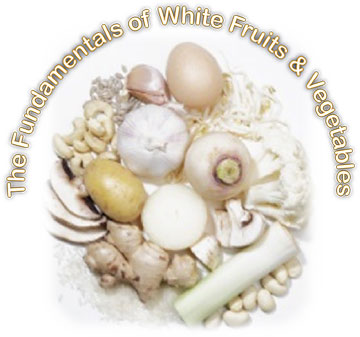
There is a misconception that white foods lack nutrients because they don’t have pigments (a.k.a. phytochemicals). Although phytochemicals are powerful antioxidants with a number of health benefits, they are not the only antioxidants found in food. Moreover, there are a number of white-fleshed foods (e.g. potatoes and pears) that have phytochemicals in their edible skin.
The health benefits of white foods need to be assessed individually, because there is no common pigment, and nutrient value varies. Below is a description of a few white fruits and vegetables.
White Fruits’ Health Benefits
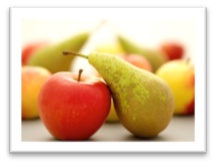 Pears and apples have a lot of nutrients in their skin, including a number of phytochemicals—the most abundant being epicatechin. Epicatechin induces changes in skeletal and cardiac muscle, which reduces the symptoms of fatigue and increases oxygen flow. [1] the skin also contains insoluble fiber, which promotes a healthy digestive system.
Pears and apples have a lot of nutrients in their skin, including a number of phytochemicals—the most abundant being epicatechin. Epicatechin induces changes in skeletal and cardiac muscle, which reduces the symptoms of fatigue and increases oxygen flow. [1] the skin also contains insoluble fiber, which promotes a healthy digestive system.
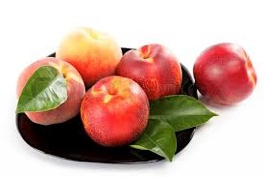 Peaches and nectarines belong to the same family as pears. The flesh is less acidic, so they are a better option if you suffer from heartburn or stomach ulcers. Peaches and nectarines are high in fiber and can be used as a gentle laxative. They are also a good source of vitamin C, which is a powerful antioxidant that also boosts your immune system. [2]
Peaches and nectarines belong to the same family as pears. The flesh is less acidic, so they are a better option if you suffer from heartburn or stomach ulcers. Peaches and nectarines are high in fiber and can be used as a gentle laxative. They are also a good source of vitamin C, which is a powerful antioxidant that also boosts your immune system. [2]
 Bananas are high in potassium. The body uses potassium to regulate metabolism and cell membrane permeability. One medium banana contains 422 mg. Children need at least 3,000 mg daily. [3] Potassium deficiency can lead to constipation, fatigue, and muscle damage/ weakness. [4]
Bananas are high in potassium. The body uses potassium to regulate metabolism and cell membrane permeability. One medium banana contains 422 mg. Children need at least 3,000 mg daily. [3] Potassium deficiency can lead to constipation, fatigue, and muscle damage/ weakness. [4]
White Vegetables’ Health Benefits
 Garlic contains a number of sulfur-derived chemicals that reduce cell damage caused by oxidative stress. The most studied is allicin. Allicin is part of the plant’s natural defense against pests and microorganisms. When digested, allicin helps our body fight pathogenic bacteria and viruses. Additionally, it acts like an antioxidant by eliminating cancer-causing free radicals in the body. [5]
Garlic contains a number of sulfur-derived chemicals that reduce cell damage caused by oxidative stress. The most studied is allicin. Allicin is part of the plant’s natural defense against pests and microorganisms. When digested, allicin helps our body fight pathogenic bacteria and viruses. Additionally, it acts like an antioxidant by eliminating cancer-causing free radicals in the body. [5]
 Potatoes have a bad reputation because most are consumed as French fries or loaded baked potatoes. Potatoes are healthy if not topped with fats or deep-fried. In fact, they contain 60 different phytochemicals and vitamins.6 Cartenoids, vitamin C, vitamin B6, tryptophan, and magnesium are present in high quantities. The nutrient combination is known to lower the risk of cardiovascular disease, maintain neurological activity, and help your body break down sugar for energy. [6]
Potatoes have a bad reputation because most are consumed as French fries or loaded baked potatoes. Potatoes are healthy if not topped with fats or deep-fried. In fact, they contain 60 different phytochemicals and vitamins.6 Cartenoids, vitamin C, vitamin B6, tryptophan, and magnesium are present in high quantities. The nutrient combination is known to lower the risk of cardiovascular disease, maintain neurological activity, and help your body break down sugar for energy. [6]
 Cauliflower is full of nutrients such as vitamin B, potassium, vitamin C, and fiber. Fiber is imperative for a healthy digestive system (the average intake is less than half the recommended levels9). Vitamin B and vitamin C are known to boost your immune system.7 Vitamin C, like all antioxidants, also helps fight cancer. As mentioned before, potassium is an essential component to metabolism and cell permeability, and it also helps regulate various stress hormones. [8]
Cauliflower is full of nutrients such as vitamin B, potassium, vitamin C, and fiber. Fiber is imperative for a healthy digestive system (the average intake is less than half the recommended levels9). Vitamin B and vitamin C are known to boost your immune system.7 Vitamin C, like all antioxidants, also helps fight cancer. As mentioned before, potassium is an essential component to metabolism and cell permeability, and it also helps regulate various stress hormones. [8]
Adding a wide variety of white fruits and vegetables is important in order to take full advantage of the wide range of benefits. Below are two easy recipes that your family will enjoy.
3 Fruit Smoothie from http://www.low-cholesterol.food.com
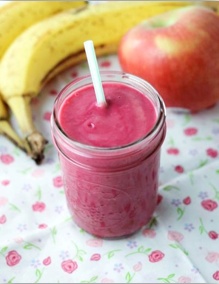
Ingredients:
• 2 bananas
• 4 peaches sliced
• 8 strawberries
• 2-3 c organic apple juice (dependent on desired thickness) – Can use half water, half juice to reduce sweetness
• ¼ tsp cinnamon
Directions:
Combine ingredients. Blend in blender until smooth.
Hot Potato Salad from http://www.thisamericanbite.com
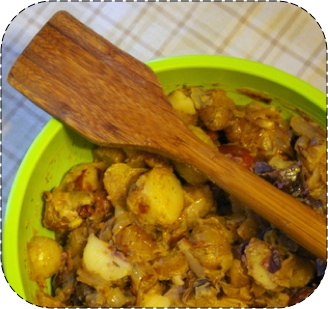
Ingredients:
• 1 lb bag of potatoes
• 1 onion, diced
• 6 cloves of garlic
• Dijon mustard (do not substitute with yellow mustard)
• Fresh dill
• Thyme
• Salt
• Pepper
• Olive oil
Directions:
1. Cut potatoes so they are all a similar size. Put them in a pot of cold water along with five or six cloves of garlic and place the covered pot on a low heat.
2. Allow the water to come to the boil until you can put a fork through a potato with no effort (10 -15 minutes after the water starts to boil).
3. While the potatoes are cooking, fry some onions in olive oil until they start to brown, season the onions with thyme, salt, and pepper.
4. When the potatoes have cooked, drain the water. Combine potatoes and onions, and add 1 tablespoon of Dijon mustard, a generous sprinkle of dill (dried is fine), a dash of salt and pepper.
5. Combine the ingredients gently. Don’t mix too hard, because you want to avoid mashing the potatoes. Drizzle with a little extra virgin olive oil to bring the flavors together, and give the potato salad a shiny finish.
Article Resources
1 http://www.ncbi.nlm.nih.gov/pubmed/21788351
2 http://www.webmd.com/diet/features/the-benefits-of-vitamin-c?page=2
3 http://lpi.oregonstate.edu/infocenter/minerals/potassium/
4 http://www.nlm.nih.gov/medlineplus/ency/article/000479.htm
5 http://www.phytochemicals.info/phytochemicals/allicin.php
6 http://www.whfoods.com/genpage.php?tname=foodspice&dbid=48
7 http://www.livestrong.com/article/22117-benefits-b-complex-vitamins/
8 http://www.organicfacts.net/health-benefits/minerals/health-benefits-of-potassium.html
9 http://www.ncbi.nlm.nih.gov/pubmed/19335713



